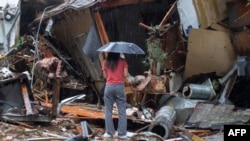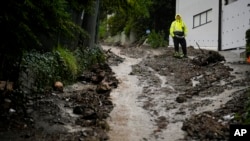One of the wettest storms in Southern California history unleashed nearly 400 mudslides in the Los Angeles area after dumping more than half the amount of rainfall the city typically gets in a season in two days. Officials warned Tuesday that the threat was not over yet.
The storm continued to pose new hazards, with the National Weather Service issuing a rare tornado warning for San Diego County. The warning was cancelled shortly after it was issued, with forecasters explaining that the storm no longer appeared capable of producing a twister even if it briefly turned some San Diego streets into rivers.
Officials expressed relief that the storm hadn’t yet killed anyone or caused a major catastrophe in Los Angeles despite its size and intensity, though there were seven deaths reported elsewhere, including one early Tuesday at the California-Mexico border when someone trying to enter the United States was swept up by a swollen Tijuana River channel, according to U.S. Customs and Border Protection.
In the city of Los Angeles — the largest city in the U.S. state of California — Mayor Karen Bass thanked residents for heeding calls to stay off roads and urged people to continue doing so through the end of Tuesday, when the rain was expected to stop.
“Los Angeles can handle very big challenges. And if we stick together, we will come out so far ahead,” she said.
The slow-moving storm that blew into the city on Sunday and then parked itself could still produce fierce downpours of up to an inch (roughly 2.5 centimeters) of rain in an hour, the weather service said. That could be particularly precarious since the soil is already saturated after back-to-back atmospheric rivers walloped California in less than a week.
Crews have responded to 383 mudslides, and seven buildings have been deemed uninhabitable, officials said. Another 10 buildings were yellow-tagged, meaning residents could go back to get their belongings but could not stay there because of the damage.
Bass said the city does not yet have the total number of homes that were damaged by the storm and noted the city’s emergency shelters were full.
Dion Peronneau was trying to get her artwork and books out of her home, which was smashed into by a mudslide.
“Eight feet of mud is pressed up against my window that is no longer there,” she said. “They put up boards to make sure no more mud can come in.”
Despite the damage, she said she was grateful no one was hurt when the mud knocked her sliding glass doors off their frame and came pouring into her home of 25 years.
The California Highway Patrol said a 69-year-old man died Monday after his truck went down an embankment and filled with water in Yucaipa, about 80 miles (128 kilometers) east of Los Angeles. Another accident in nearby Fontana killed a 23-year-old man after the car he was in crashed into a tow truck in the rain, the agency said.
Four people were killed in Northern California after the storm came ashore over the weekend with strong winds that toppled trees. They included a 63-year-old woman who was found dead Tuesday under a large tree in her backyard in Fair Oaks, Sacramento County officials reported.
Most of Southern California remained under flood watches, and the weather service warned people to remain on high alert as swollen and fast-moving creeks and rivers increase the risk of drowning and the need for swift-water rescues.
“This has truly been a historic storm for Los Angeles,” Ariel Cohen, a meteorologist at the National Weather Service’s Los Angeles-area bureau, told reporters, noting that the city had just recorded its third-wettest two-day stretch since record keeping began in the 1870s.
Between 6 and 12 inches (15.2 and 30.5 centimeters) of rain has fallen over Los Angeles and saturated the ground, which can increase the risk of landslides long after a storm passes, officials said.
An evacuation order was issued for a Los Angeles canyon area that was scarred by a 2022 fire. Scarring from fires contributed to a tragic 2018 mudslide in Montecito, near Santa Barbara, that destroyed 130 homes and killed 23 people, making it one of the deadliest in California history.
Crews rescued people from swift-moving water in various parts of Southern California, including 16 people and five cats in Los Angeles County alone, authorities said. About an hour’s drive east in San Bernardino, two homeless people were rescued Monday after spending the night on a small island in the Santa Ana River, and three others were helped after they climbed into a tree above raging floodwaters that submerged their vehicle.
Authorities also reported several spills of raw sewage into the Pacific and closed affected Los Angeles-area beaches.
Near the Hollywood Hills, dotted with multimillion-dollar homes, floodwaters carried mud, rocks and household objects downhill through Studio City, officials said. Sixteen people were evacuated, and several homes were severely damaged.
Downtown Los Angeles received nearly 7 inches (18 centimeters) of rain by Monday night, nearly half the yearly average of 14.25 inches (36 centimeters).
Governor Gavin Newsom declared a state of emergency for most of coastal Southern California, and on Monday, U.S. President Joe Biden promised federal help.
The phenomenon known as El Nino is expected to bring additional storms to California this year, caused by the temporary warming of parts of the Pacific that changes weather worldwide.
Many businesses said they will be feeling the effects of a sales downturn long after the storm has gone.
At The Flowerman in Pasadena, florist and owner Lou Quismorio said that this close to Valentine’s Day, he would typically have a “pretty crowded store.” He hopes customers return with the sun.
“I can’t really worry about it,” he said. “I’ve got over 8,500 roses in my cooler right now.”
In San Diego, Sabrina Biddle was cleaning up after a few “leaks” in her dance studio.
“Back to dancing, no more storm,” she said.


